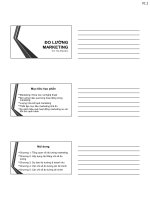Lecture Marketing metrics: Chapter 4 - Trần Nhật Minh
Bạn đang xem bản rút gọn của tài liệu. Xem và tải ngay bản đầy đủ của tài liệu tại đây (912.58 KB, 22 trang )
9/18/2015
Chapter 4:
Non-financial metrics
Contents
• Product and portfolio management
• Pricing strategy
• Chanel and retail management
• Marketing communication metrics
Product & portfolio
management
1
9/18/2015
Key metrics
• Products
◦ Trial
◦ Repeat volume
◦ Penetration
◦ Volume projection
• Customers
◦ Awareness, Attitude, and Usage (AAU)
◦ Customer satisfaction
◦ Recency, Retention rate
◦ Customer profit
◦ Customer Lifetime Value (CLV)
◦ Prospect Lifetime Value
Trial, repeat, penetration and
volume projection
• Purpose: to understand volume projections
• Trial rate (%): the percentage of a defined
population that purchases or uses a product for the
first time in a given period.
• First-time triers in period t (#): the number of
customers who purchases or use a product or
brand for the first time in a given period
Trial, repeat, penetration and
volume projection
• 𝑻𝒓𝒊𝒂𝒍 𝒓𝒂𝒕𝒆 % =
𝐹𝑖𝑟𝑠𝑡 𝑡𝑖𝑚𝑒 𝑡𝑟𝑖𝑒𝑟𝑠 𝑖𝑛 𝑝𝑒𝑟𝑖𝑜𝑑 𝑡(#)
𝑇𝑜𝑡𝑎𝑙 𝑝𝑜𝑝𝑢𝑙𝑎𝑡𝑖𝑜𝑛 (#)
• 𝑷𝒆𝒏𝒆𝒕𝒓𝒂𝒕𝒊𝒐𝒏 𝒕 # = 𝑃𝑒𝑛𝑒𝑡𝑟𝑎𝑡𝑖𝑜𝑛 𝑖𝑛 𝑡 − 1 # ∗
2
9/18/2015
Volume projection
• 𝑻𝒐𝒕𝒂𝒍 𝒗𝒐𝒍𝒖𝒎𝒆 # = 𝑇𝑟𝑖𝑎𝑙 𝑣𝑜𝑙𝑢𝑚𝑒 # +
𝑅𝑒𝑝𝑒𝑎𝑡 𝑣𝑜𝑙𝑢𝑚𝑒 #
Volume projection
• Trial volume:
◦ 𝑻𝒓𝒊𝒂𝒍 𝒗𝒐𝒍𝒖𝒎𝒆 # = 𝑇𝑟𝑖𝑎𝑙 𝑝𝑜𝑝𝑢𝑙𝑎𝑡𝑖𝑜𝑛 # ∗
𝑈𝑛𝑖𝑡𝑠 𝑝𝑒𝑟 𝑝𝑢𝑟𝑐ℎ𝑎𝑠𝑒 #
◦ 𝑻𝒓𝒊𝒂𝒍 𝒑𝒐𝒑𝒖𝒍𝒂𝒕𝒊𝒐𝒏 # = 𝑇𝑎𝑟𝑔𝑒𝑡 𝑝𝑜𝑝𝑢𝑙𝑎𝑡𝑖𝑜𝑛 # ∗
𝐴𝑑𝑗𝑢𝑠𝑡𝑒𝑑 𝑡𝑟𝑖𝑎𝑙 𝑟𝑎𝑡𝑒(%)
◦ 𝑨𝒅𝒋𝒖𝒔𝒕𝒆𝒅 𝒕𝒓𝒊𝒂𝒍 𝒓𝒂𝒕𝒆 % = 𝑇𝑟𝑖𝑎𝑙 𝑟𝑎𝑡𝑒 % ∗
𝐴𝑤𝑎𝑟𝑒𝑛𝑒𝑠𝑠 % ∗ 𝐴𝐶𝑉(%)
Volume projection
• Repeat volume:
◦ 𝑹𝒆𝒑𝒆𝒂𝒕 𝒗𝒐𝒍𝒖𝒎𝒆 # = 𝑅𝑒𝑝𝑒𝑎𝑡 𝑏𝑢𝑦𝑒𝑟𝑠 # ∗
𝑅𝑒𝑝𝑒𝑎𝑡 𝑢𝑛𝑖𝑡 𝑣𝑜𝑙𝑢𝑚𝑒 𝑝𝑒𝑟 𝑐𝑢𝑠𝑡𝑜𝑚𝑒𝑟 # ∗
𝑅𝑒𝑝𝑒𝑎𝑡 𝑜𝑐𝑐𝑎𝑠𝑖𝑜𝑛𝑠(#)
◦ 𝑹𝒆𝒑𝒆𝒂𝒕 𝒃𝒖𝒚𝒆𝒓𝒔 # = 𝑇𝑟𝑖𝑎𝑙 𝑝𝑜𝑝𝑢𝑙𝑎𝑡𝑖𝑜𝑛 # ∗
𝑅𝑒𝑝𝑒𝑎𝑡 𝑟𝑎𝑡𝑒(%)
3
9/18/2015
Awareness, Attitudes, and
Usage (AAU)
• Awareness & Knowledge:
◦ Awareness: the percentage of potential customers or
consumers who recognize a given brand.
◦ Knowledge: the percentage of surveyed customers who
demonstrate specific knowledge or beliefs about a brand
or products.
Awareness, Attitudes, and
Usage (AAU)
• Attitude: A combination of what consumer believe
and how strongly they feel about it.
◦ Attitude/Liking/Image
◦ Perceived value for money
◦ Perceived quality/esteem
◦ Intentions
◦ Purchase intentions
Awareness, Attitudes, and
Usage (AAU)
• Usage: A measure of customers’ self-reported
behaviors.
◦ Identifying customers’ usage behaviors.
4
9/18/2015
Awareness, Attitudes, and
Usage (AAU)
• Cautions:
◦ Periodic changes
◦ Customer and non-customer responses
◦ Triangulate customer survey data with sales revenue or
other data related to business performance
◦ Separate leading from lagging indicators.
Customer satisfaction
• Purpose: provides a leading indicator for consumer
purchase intentions and loyalty.
• Customer satisfaction: The number of customers,
or percentage of total customers, whose reported
experience with a firm, its products, or its services
(ratings) exceeds specified satisfaction goals.
Customer satisfaction
• Cautions:
◦ Response bias from disappointed or angry customer.
◦ Sample selection: satisfaction is calculated based on
surveyed customers.
◦ Change in customers’ expect�����������������������������������������������������������������������������������������������������������������������������������������������������������������������������������������������������������������������������������������������������������������������������������������������������������������������������������������������������������������������������������������������������������������������������������������������������������������������������������������������������������������������������������������������������������������������������������������������������������������������������������������������������������������������������������������������������������������������������������������������������������������������������������������������������������������������������������������������������������������������������������������������������������������������������������������������������������������������������������������������������������������������������������������������������������������������������������������������������������������������������������������������������������������������������������������������������������������������������������������������������������������������������������������������������������������������������������������������������������������������������������������������������������������������������������������������������������������������������������������������������������������������������������������������������������������������������������������������������������������������������������������������������������������������������������������������������������������������������������������������������������������������������������������������������������������������������������������������������������������������������������������������������������������������������������������������������������������������������������������������������������������������������������������������������������������������������������������������������������������������������������������������������������������������������������������������������������������������������������������������������������������������������������������������������������������������������������������������������������������������������������������������������������������������������������������������������������������������������������������������������������������������������������������������������������������������������������������������������������������������������������������������������������������������������������������������������������������������������������������������������������������������������������������������������������������������������������������������������������������������������������������������������������������������������������������������������������������������������������������������������������������������������������������������������������������������������������������������������������������������������������������������������������������������������������������������������������������������������������������������������������������������������������������������������������������������������������������������������������������������������������������������������������������������������������������������������������������������������������������������������������������������������������������������������������������������������������������������������������������������������������������������������������������������������������������������������������������������������������������������������������������������������������������������������������������������������������������������������������������������������������������������������������������������������������������������������������������������������������������������������������������������������������������������������������������������������������������������������������������������������������������������������������������������������������������������������������������������������������������������������������������������������������������������������������������������������������������������������������������������������������������������������������������������������������������������������������������������������������������������������������������������������������������������������������������������������������������������������������������������������������������������������������������������������������������������������������������������������������������������������������������������������������������������������������������������������������������������������������������������������������������������������������������������������������������������������������������������������������������������������������������������������������������������������������������������������������������������������������������������������������������������������������������������������������������������������������������������������������������������������������������������������������������������������������������������������������������������������������������������������������������������������������������������������������������������������������������������������������������������������������������������������������������������������������������������������������������������������������������������������������������������������������������������������������������������������������������������������������������������������������������������������������������������������������������������������������������������������������������������������������������������������������������������������������������������������������������������������������������������������������������������������������������������������������������������������������������������������������������������������������������������������������������������������������������������������������������������������������������������������������������������������������������������������������������������������������������������������������������������������������������������������������������������������������������������������������������������������������������������������������������������������������������������������������������������������������������������������������������������������������������������������������������������������������������������������������������������������������������������������������������������������������������������������������������������������������������������������������������������������������������������������������������������������������������������������������������������������������������������������������������������������������������������������������������������������������������������������������������������������������������������������������������������������������������������������������������������������������������������������������������������������������������������������������������������������������������������������������������������������������������������������������������������������������������������������������������������������������������������������������������������������������������������������������������������������������������������������������������������������������������������������������������������������������������������������������������������������������������������������������������������������������������������������������������������������������������������������������������������������������������������������������������������������������������������������������������������������������������������������������������������������������������������������������������������������������������������������������������������������������������������������������������������������������������������������������������������������������������������������������������������������������������������������������������������������������������������������������������������������������������������������������������������������������������������������������������������������������������������������������������������������������𝑜𝑠𝑡 $
• 𝑫𝒊𝒓𝒆𝒄𝒕 𝒑𝒓𝒐𝒅𝒖𝒄𝒕 𝒄𝒐𝒔𝒕 $ =
𝑊𝑎𝑟𝑒ℎ𝑜𝑢𝑠𝑒 𝑑𝑖𝑟𝑒𝑐𝑡 𝑐𝑜𝑠𝑡 $ +
𝑇𝑟𝑎𝑛𝑠𝑝𝑜𝑟𝑡𝑎𝑡𝑖𝑜𝑛 𝑑𝑖𝑟𝑒𝑠𝑡 𝑐𝑜𝑠𝑡 $ + 𝑆𝑡𝑜𝑟𝑒 𝑑𝑖𝑟𝑒𝑐𝑡 𝑐𝑜𝑠𝑡($)
Marketing
communication
metrics
Key metrics
• Promotion
◦ Baseline sales
◦ Promotion lift
• Advertising media metrics
◦ Opportunities to see (OTS)
◦ Gross Rating Points (GRPs)
◦ Share of Voice
• Web metrics
◦ Impressions
◦ Clickthrough rate
◦ Cost per impression, click, order
15
9/18/2015
Promotion:
Baseline sales, incremental sales, promotional lift
• Purpose: To select a baseline of sales against
which the incremental sales and profit generated
by marketing activity can be assessed.
Promotion:
Baseline sales, incremental sales, promotional lift
• 𝑻𝒐𝒕𝒂𝒍 𝒔𝒂𝒍𝒆𝒔 $, # = 𝐵𝑎𝑠𝑒𝑙𝑖𝑛𝑒 𝑠𝑎𝑙𝑒𝑠 $, # +
𝐼𝑛𝑐𝑟𝑒𝑚𝑒𝑛𝑡𝑎𝑙 𝑠𝑎𝑙𝑠𝑒 𝑓𝑟𝑜𝑚 𝑚𝑎𝑟𝑘𝑒𝑡𝑖𝑛𝑔 $, #
• 𝑳𝒊𝒇𝒕 % =
𝐼𝑛𝑐𝑟𝑒𝑚𝑒𝑛𝑡𝑎𝑙 𝑠𝑎𝑙𝑒𝑠 $,#
𝐵𝑎𝑠𝑒𝑙𝑖𝑛𝑒 𝑠𝑎𝑙𝑒𝑠 ($,#)
• 𝑪𝒐𝒔𝒕 𝒐𝒇 𝒊𝒏𝒄𝒓𝒆𝒎𝒆𝒏𝒕𝒂𝒍 𝒔𝒂𝒍𝒆𝒔 $ =
𝑀𝑎𝑟𝑘𝑒𝑡𝑖𝑛𝑔 𝑠𝑝𝑒𝑛𝑑𝑖𝑛𝑔 ($)
𝐼𝑛𝑐𝑟𝑒𝑚𝑒𝑛𝑡𝑎𝑙 𝑠𝑎𝑙𝑒𝑠 ($)
Promotion:
Baseline sales, incremental sales, promotional lift
• Baseline sales:
◦ Expected sales results, excluding the marketing programs
under evaluation.
16
9/18/2015
Promotion:
Profitability of a promotion
• 𝑷𝒓𝒐𝒇𝒊𝒕𝒂𝒃𝒊𝒍𝒊𝒕𝒚 𝒐𝒇 𝒂 𝒑𝒓𝒐𝒎𝒐𝒕𝒊𝒐𝒏 $ =
𝑃𝑟𝑜𝑓𝑖𝑡𝑠 𝑎𝑐ℎ𝑖𝑣𝑒𝑑 𝑤𝑖𝑡ℎ 𝑝𝑟𝑜𝑚𝑜𝑡𝑖𝑜𝑛 $ −
𝐸𝑠𝑡𝑖𝑚𝑎𝑡𝑒𝑑 𝑝𝑟𝑜𝑓𝑖𝑡𝑠 𝑤𝑖𝑡ℎ𝑜𝑢𝑡 𝑝𝑟𝑜𝑚𝑜𝑡𝑖𝑜𝑛 $
• Estimated profits without promotion: profits calculated on
baseline sales
Advertising Media
Impressions, Gross rating Points (GRPs), Target
Rating Points (TRPs)
Impressions
• Purpose: To measure the audience for an
advertisement.
• Impressions = Exposures = Opportunities To See
(OTS)
• Impressions: the number of times a specific
advertisement is delivered to a potential customer.
• An estimate of the audience for a media
“insertion” or a campaign.
17
9/18/2015
Impressions
• 𝑰𝒎𝒑𝒓𝒆𝒔𝒔𝒊𝒐𝒏𝒔 # = 𝑅𝑒𝑎𝑐ℎ # ∗ 𝐴𝑣𝑒𝑟𝑎𝑔𝑒 𝑓𝑟𝑒𝑞𝑢𝑒𝑛𝑐𝑦 #
• 𝑹𝒆𝒂𝒄𝒉 # =
𝐼𝑚𝑝𝑒𝑟𝑠𝑠𝑖𝑜𝑛(#)
𝐴𝑣𝑒𝑟𝑎𝑔𝑒 𝑓𝑟𝑒𝑞𝑢𝑒𝑛𝑐𝑦(#)
Gross Rating Points (GRPs)
• Reach [Rating points – (%)]: calculated as
individuals reached by that vehicle, divided by the
total number of individuals in a defined
population.
• Gross Rating Points (GRPs): the sum of all rating
points delivered by the media vehicle carrying an
advertisement or campaign.
Gross Rating Points (GRPs)
• 𝑮𝑹𝑷𝒔 = 𝑅𝑒𝑎𝑐ℎ % ∗ 𝐴𝑣𝑒𝑟𝑎𝑔𝑒 𝑓𝑟𝑒𝑞𝑢𝑒𝑛𝑐𝑦 # ∗
100%
𝐼𝑚𝑝𝑒𝑟𝑠𝑠𝑖𝑜𝑛(#)
• 𝑮𝑹𝑷𝒔 = 𝐷𝑒𝑓𝑖𝑛𝑒𝑑 𝑝𝑜𝑝𝑢𝑙𝑎𝑡𝑖𝑜𝑛(#) ∗ 100%
18
9/18/2015
Target Rating Points (TRPs)
• Target Rating Points (TRPs): the gross rating
points delivered by a media vehicle to a specific
target audience.
• 𝑻𝑹𝑷𝒔 = 𝑅𝑒𝑎𝑐ℎ % ∗ 𝐴𝑣𝑒𝑟𝑎𝑔𝑒 𝑓𝑟𝑒𝑞𝑢𝑒𝑛𝑐𝑦 # ∗
100%
• 𝑻𝑹𝑷𝒔 =
𝐼𝑚𝑝𝑒𝑟𝑠𝑠𝑖𝑜𝑛(#)
𝑇𝑎𝑟𝑔𝑒𝑡(#)
∗ 100%
Cost per Thousand
Impressions (CPM) Rate
• Purpose: to compare the costs of advertising
campaigns within and across different media.
• CPM: The cost of a media campaign, relative to its
success in generating impressions or opportunities
to see.
Cost per Thousand
Impressions (CPM) Rate
𝐴𝑑𝑣𝑒𝑟𝑡𝑖𝑠𝑖𝑛𝑔 𝑐𝑜𝑠𝑡($)
• 𝐶𝑃𝑀 $ = 𝐼𝑚𝑝𝑟𝑒𝑠𝑠𝑖𝑜𝑛 𝑔𝑒𝑛𝑒𝑟𝑎𝑡𝑒𝑑(# 𝑖𝑛 𝑡ℎ𝑜𝑢𝑠𝑎𝑛𝑑)
19
9/18/2015
Share of voice
• Purpose: to evaluate the comparative level of
advertising committed to a specific product or
brand.
• Share of voice: the percentage of advertising in a
given market that a specific product or brand
enjoys.
Share of voice
• 𝑺𝒉𝒂𝒓𝒆 𝒐𝒇 𝒗𝒐𝒊𝒄𝒆 % =
𝐵𝑟𝑎𝑛𝑑 𝑎𝑑𝑣𝑒𝑟𝑡𝑖𝑠𝑖𝑛𝑔 ($,#)
𝑇𝑜𝑡𝑎𝑙 𝑀𝑎𝑟𝑘𝑒𝑡 𝐴𝑑𝑣𝑒𝑟𝑡𝑖𝑠𝑖𝑛𝑔($,#)
Web metrics
• Impressions, Pageviews, Hits:
◦ Purpose: to assess website traffic and activity.
◦ Pageviews: the number of times a specific page has been
displayed to users (equal to OTS)
◦ Hits: A count of the number of files served to visitors on
the web.
20
9/18/2015
Web metrics: rich media
• Rich media display time:
◦ Purpose: to determine how long an advertisement is
viewed.
◦ 𝑨𝒗𝒆𝒓𝒂𝒈𝒆 𝒓𝒊𝒄𝒉 𝒎𝒆𝒅𝒊𝒂 𝒅𝒊𝒔𝒑𝒍𝒂𝒚 𝒕𝒊𝒎𝒆 # =
𝑇𝑜𝑡𝑎𝑙 𝑟𝑖𝑐ℎ 𝑚𝑒𝑑𝑖𝑎 𝑑𝑖𝑠𝑝𝑙𝑎𝑦 𝑡𝑖𝑚𝑒(#)
𝑇𝑜𝑡𝑎𝑙 𝑟𝑖𝑐ℎ 𝑚𝑒𝑑𝑖𝑎 𝑖𝑚𝑝𝑟𝑒𝑠𝑠𝑖𝑜𝑛𝑠(#)
Web metrics: rich media
• Rich media Interaction rate:
◦ Purpose: to measure and monitor active involvement
with an advertisement.
◦ 𝑹𝒊𝒄𝒉 𝒎𝒆𝒅𝒊𝒂 𝒊𝒏𝒕𝒆𝒓𝒂𝒄𝒕𝒊𝒐𝒏 𝒓𝒂𝒕𝒆 % =
𝑇𝑜𝑡𝑎𝑙 𝑟𝑖𝑐ℎ 𝑚𝑒𝑑𝑖𝑎 𝑖𝑚𝑝𝑟𝑒𝑠𝑠𝑖𝑜𝑛𝑠 𝑤𝑖𝑡ℎ 𝑖𝑛𝑡𝑒𝑟𝑎𝑐𝑡𝑖𝑜𝑛𝑠(#)
𝑇𝑜𝑡𝑎𝑙 𝑟𝑖𝑐ℎ 𝑚𝑒𝑑𝑖𝑎 𝑖𝑚𝑝𝑟𝑒𝑠𝑠𝑖𝑜𝑛𝑠(#)
Web metrics: clickthrough
rates
• Clickthrough rate:
◦ Purpose: to capture customer’s initial response to
websites.
◦ 𝑪𝒍𝒊𝒄𝒌𝒕𝒉𝒓𝒐𝒖𝒈𝒉 𝒓𝒂𝒕𝒆 % =
𝐶𝑙𝑖𝑐𝑘𝑡ℎ𝑟𝑜𝑢𝑔ℎ(#)
𝐼𝑚𝑝𝑟𝑒𝑠𝑠𝑖𝑜𝑛𝑠(#)
◦ Clickthrough: The number of times a click is made on the
advertisement.
21
9/18/2015
Web metrics: Costs
• Purpose: to capture customer’s initial response to
websites.
◦ Cost per impression
◦ Cost per click
◦ Cost per order
Web metrics: Costs
• 𝑪𝒐𝒔𝒕 𝒑𝒆𝒓 𝒊𝒎𝒑𝒓𝒆𝒔𝒔𝒊𝒐𝒏($) =
• 𝑪𝒐𝒔𝒕 𝒑𝒆𝒓 𝒄𝒍𝒊𝒄𝒌($) =
𝐴𝑑𝑣𝑒𝑟𝑡𝑖𝑠𝑖𝑛𝑔 𝑐𝑜𝑠𝑡($)
𝑁𝑢𝑚𝑏𝑒𝑟 𝑜𝑓 𝑖𝑚𝑝𝑟𝑒𝑠𝑠𝑖𝑜𝑛𝑠(#)
𝐴𝑑𝑣𝑒𝑟𝑡𝑖𝑠𝑖𝑛𝑔 𝑐𝑜𝑠𝑡($)
𝑁𝑢𝑚𝑏𝑒𝑟 𝑜𝑓 𝑐𝑙𝑖𝑐𝑘𝑠(#)
• 𝑪𝒐𝒔𝒕 𝒑𝒆𝒓 𝒐𝒓𝒅𝒆𝒓($) =
𝐴𝑑𝑣𝑒𝑟𝑡𝑖𝑠𝑖𝑛𝑔 𝑐𝑜𝑠𝑡($)
𝑁𝑢𝑚𝑏𝑒𝑟 𝑜𝑓 𝑜𝑟𝑑𝑒𝑟𝑠(#)
22









